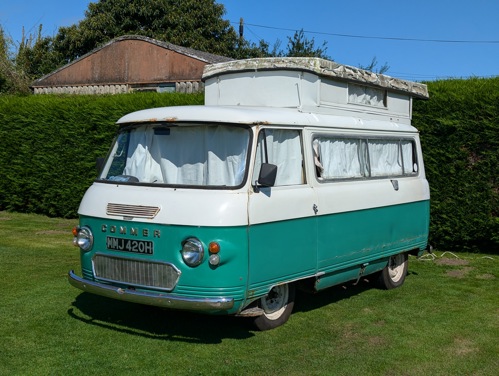The Ultimate Commer Camper?
05 September 2025
The Commer FC/PA/PB/Spacevan enjoyed a production run that lasted from 1960 to 1983, and for many years, it was part of the UK’s automotive landscape. Diaries used them as milk floats, police forces as Black Marias, while public utility bodies employed vast fleets of Commers. In 1966 alone, the GPO placed a £400,000 order for 600 Post Office Telephones vans.
The Spacevan was also the basis for a variety of motor home conversions; Auto-sleepers Ltd described their camper van as “The Cheerful Cruiser”. What the Commer family was not renowned for was their turn of speed - but Eloise’s 1970 camper is rather different from the average Spacevan. She bought it in 2018 and:
I had a second-hand Holbay engine in the garage (as you do), which I took to Coltec Racing Engines in Hollesley Bay (which is where the name Holbay comes from). The owner used to work at Holbay and knows these engines inside out. The standard Holbay was 1725cc, as used in the Sunbeam Rapier H120 and Hillman Hunter GLS, with twin Weber 40DCOE carbs. In addition to rebuilding to standard specifications, Coltec offers bored-out versions, and I opted for the Holbay Marathon, resulting in a displacement of 1866cc.

Once the engine was ready, Eloise drove the Commer to Coltec, where the engine swap commenced:
As there isn’t room in the engine bay for the DCOEs, I bought a Weber 32/36 downdraft carb kit and inlet manifold from Alpine Innovations. The background to the kit is that it was developed specifically for Sunbeam Alpines and has also been used successfully in Sunbeam Rapiers. Like those in the Alpines and Series Rapiers, the Commer engine is mounted upright, and they are all the same family of engines. The manifold went straight on with no issues, whereas the engines in the Arrow range of cars, including H120 and GLS, were slanted.
Eloise also needed a new exhaust manifold, as the old one was in poor condition and did not match the ports on the Holbay head. As for the actual fitting of the new power plant:
Coltec had to do some machining on the Plenum chamber to reduce its height so it would fit under the engine cover. The engine bay is located under the middle seat in the cab, and Coltec was able to remove the old one and install the new one without having to remove the windscreen, which was a relief – apparently, they used to do that back in the day.

The difference in performance, post-engine conversion, was quite remarkable. Eloise remarks:
I don’t know the exact bhp of the original engine, but it was around 45-50, possibly less with age, and the new engine is 130+. Previously, I had to drive everywhere foot to the floor, and not only was it slow, but on the slightest incline, the Commer would begin to slow down.
On motorways in the slow lane, I would get lorries coming up behind me and flashing, and I just couldn’t go any faster. Plus, I was getting about 15mpg, which with a nine-gallon tank meant I had petrol station anxiety the whole time. With the Holbay, I can keep up with modern traffic around town, accelerate up hills, and have no more problems with lorries! Better still, I am now getting about 25-28mpg as I’m not having to cane the engine the whole time. The overdrive box also makes a meaningful difference now, given the increased power.
And such enhanced performance is combined with the practicality of the Auto-sleeper camper conversion. Eloise says:
It still has the original interior, with a two-hob gas stove plus grill, a gas fridge, and sink with a foot pump on the floor to pump water through. It’s a 4-berth – the table goes down between the two seats in the back to make a 6ft double bed, the bench seat in the cab folds down to make a single bed, and there is a sturdy pull-out hammock the full length of the back as well.
The public’s reaction to the mighty Comme has been very positive. In Eloise's experience:
Whenever I take it along to shows, people are both curious and complimentary, and children and adults alike seem to like climbing inside and seeing what it’s like, and are usually surprised at how spacious and practical it is, especially when I show them the hidden features (stove, sink, fridge, etc). Personally I think it is a very well designed interior, and because the doors are at the back, I think it is much more usable than equivalent VW camper vans of the time, as both full sides of the interior are used (unlike the VW where the sliding door on the side, and engine at the back mean there is a lot less usable space). Interestingly, there were a couple of guys with Fords at Gaydon who came over and had a look at my Commer, and when I told them about wanting to restore it, they said I should leave it as it is, saying the rust and patina give it character.
Absolutely!
With thanks to Eloise Robinson for her time.
With thanks to Eloise Robinson for the permission to use the images in this blog.
